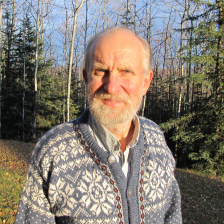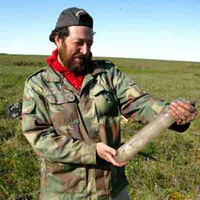Project Abstract
Permanently frozen soils, or permafrost, often contain large amounts of ground ice, which make it vulnerable to climate change and human activities. These soils are protected from melting by a surface layer which thaws in summer and refreezes in winter, and a near-surface layer, termed the transition zone. This transition zone, which develops through complex interactions between the environment and permafrost, controls permafrost resilience to ground surface subsidence (thermokarst). Expectations are that as the climate warms, deeper seasonal melting will impact this transition zone, and ecosystems and infrastructure (i.e., roads, airfields, and buildings) stability. The goals of this project are to evaluate the properties of the transition zone from the High Arctic to the southern border of the permafrost region and to understand processes of formation, degradation, and recovery of the transition zone in various climatic regions. The knowledge gained from this work will inform Arctic science and engineering. The project will support student training. The investigators will collaborate with government agencies and engineering companies whose work is impacted by permafrost ground subsidence issues.
In previous research, the investigators identified a zone in the upper profile of permafrost soils that is critical to permafrost stability, soil development, and geomorphic processes. However, how the thickness and cryostructures of this transition zone (TZ) vary across climate and landscape gradients, the rates of its formation during ecological succession, and how it contributes to permafrost vulnerability and resilience, is not well understood. What knowledge we have is in low Arctic tundra and can be misleading if applied to other bioclimatic regions. To address this gap in knowledge, our collaborative research with the University of Montreal will focus on the TZ across climatic regions and landscapes distributed along a north-south transect from barren polar deserts with continuous permafrost in Canada, to boreal forests in southern Alaska with sporadic permafrost. Our group will also monitor and experiment with mass and heat transfer processes between the active layer (AL) and the TZ to identify mechanisms controlling segregated ice formation.
Logistics Summary
Researchers on this project will assess physical principles and factors responsible for aggradation and degradation of ice-rich upper permafrost layers through extensive field studies at an array of sites representing a range of bioclimatic and landscape conditions characteristic of Arctic permafrost regions as well as analysis of available data, experimental laboratory investigation, and manipulations. During the summers of 2019 through 2022, a team of three researchers will study permafrost at sites near Tuktoyaktuk and Beaver Creek in Canada; along the Dalton, Richardson, and Parks Highways in Alaska; and at fly-in sites near Teshekpuk Lake, the Upper Colville River, the Ketik & Meade River fire scars, and the Itkillik (Stinking Hills). Field work during each year will have a duration of 15–20 days. During June and July 2019, a team of three will travel via a rental truck from Fairbanks to the road-accessible sites in Alaska via Toolik helicopter to access the Stinking Hills. During August 2019 one researcher will travel via rental truck from Fairbanks to Prudhoe Bay. In 2020 the team plans to travel via truck along the Haul Road to visit sites along the way to Toolik and Prudhoe (No Canadian field sites will be visited in 2020). In 2021, there will be a staffed field camp at Teshekpuk Lake (originally planned for 2020). Note: M. Torre Jorgenson (Alaska Ecoscience) will collaborate via a subaward issued by the University of Alaska Fairbanks (NSF funding).
Season Field Site
2019 Alaska - Beaver Creek
2019 Alaska - Colville River
2019 Alaska - Itkillik River
2019 Alaska - Ketik River
2019 Alaska - Meade River
2019 Alaska - Prudhoe Bay
2019 Alaska - Teshekpuk
2019 Alaska - Toolik
2019 Canada - Tuktoyaktuk
2020 Alaska - Beaver Creek
2020 Alaska - Colville River
2020 Alaska - Itkillik River
2020 Alaska - Ketik River
2020 Alaska - Meade River
2020 Alaska - Prudhoe Bay
2020 Alaska - Toolik
2021 Alaska - Beaver Creek
2021 Alaska - Colville River
2021 Alaska - Itkillik River
2021 Alaska - Ketik River
2021 Alaska - Meade River
2021 Alaska - Prudhoe Bay
2021 Alaska - Teshekpuk
2021 Alaska - Toolik
2021 Canada - Tuktoyaktuk
2022 Alaska - Beaver Creek
2022 Alaska - Colville River
2022 Alaska - Itkillik River
2022 Alaska - Ketik River
2022 Alaska - Meade River
2022 Alaska - Prudhoe Bay
2022 Alaska - Teshekpuk
2022 Alaska - Toolik
2022 Canada - Tuktoyaktuk
Project Location
Dates
-Location
Tuktoyaktuk, Canada; Beaver Creek, Canada; Dalton Highway, AK; Richardson Highway, AK; Parks Highway, AK; Teshekpuk Lake, AK; Upper Colville River, AK; Ketik Fire Scars, AK; Meade River Fire Scars, AK; Itkillik (Stinking Hills), AKMembers
Principal Investigator

Co-Principal Investigator

Co-Principal Investigator

